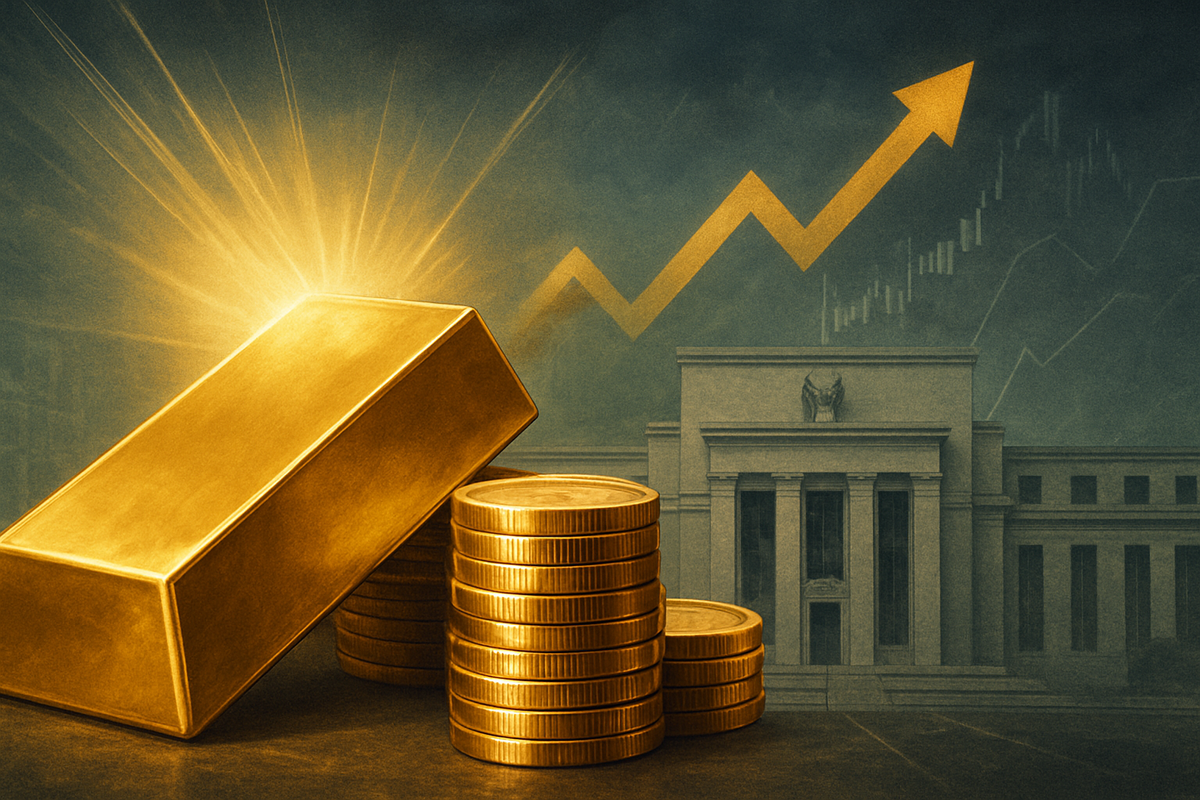Financial News
Gold Skyrockets Past $4,000 as Fed Signals Deeper Rate Cuts Amidst Economic Headwinds

In a dramatic turn of events for the financial markets, gold prices have surged past the unprecedented $4,000 mark, at one point reaching an all-time high near $4,381.58 earlier in October 2025, before consolidating around $3,980-$3,990 per ounce. This historic rally is directly tied to an aggressive monetary easing strategy by the Federal Reserve, which has signaled deeper interest rate cuts in response to a decelerating labor market, broader economic slowdowns, and persistent uncertainties, including a federal government shutdown. The precious metal's ascent underscores a growing investor flight to safety amidst a challenging economic landscape.
The immediate implications of this gold surge are profound, signaling a significant shift in investor sentiment and a heightened demand for safe-haven assets. Lower interest rates diminish the appeal of yielding assets, making non-yielding gold a more attractive alternative. This environment is fostering increased investment demand, evidenced by substantial inflows into global gold exchange-traded funds (ETFs). Furthermore, a weakening U.S. dollar, a typical consequence of rate reductions, makes gold more affordable for international buyers, expanding its global appeal. Central banks worldwide continue to bolster this trend with sustained gold purchases, diversifying their reserves and providing a strong floor for prices.
The Golden Rush: A Deep Dive into the Market's Ascent
The journey of gold prices soaring past $4,000 has been a culmination of several critical economic and monetary policy developments throughout 2025. The Federal Reserve has been at the forefront, orchestrating a series of aggressive rate reductions that have brought its benchmark rate into a target range of 3.75%-4.00% by late October. This dovish pivot is a direct response to a deteriorating economic outlook, characterized by a significant slowdown in the labor market and broader economic activity, compounded by ongoing uncertainties such as a federal government shutdown. Financial markets are not only absorbing these cuts but are also anticipating further accommodation, with many analysts projecting additional quarter-point reductions in the near future.
Historically, gold thrives in environments of economic uncertainty and monetary easing. The current scenario perfectly aligns with this pattern; as interest rates fall, the opportunity cost of holding non-yielding assets like gold decreases, making it a more attractive store of value. While Fed Chair Jerome Powell has, at times, introduced caution by downplaying the likelihood of immediate further cuts and acknowledging internal divisions, the market's conviction in continued easing remains strong, believing that economic conditions will necessitate such actions. This "hawkish cut" approach, where rates are lowered but future expectations are tempered, has occasionally led to profit-taking, yet the underlying demand for gold persists, with bargain-hunters quickly emerging on any dips below the psychological $4,000 threshold.
Key players and stakeholders in this rally include major gold mining companies, precious metal investors, and central banks. Gold mining giants such as Barrick Gold (NYSE: GOLD) and Newmont (NYSE: NEM) are poised to benefit significantly from elevated gold prices, potentially seeing increased revenues and profitability. Investors, both institutional and retail, are actively reallocating funds into gold ETFs and physical bullion, driven by a desire to hedge against economic instability and potential inflation. Central banks, notably, have maintained their role as consistent net buyers, diversifying their reserves and underpinning gold's value. Initial market reactions have been overwhelmingly positive for the precious metals sector, with silver, platinum, and palladium also experiencing substantial gains, benefiting from the same macroeconomic tailwinds and market deficits.
Corporate Fortunes: Who Wins and Who Loses in the Gold Rush
The unprecedented surge in gold prices to over $4,000, fueled by the Federal Reserve's aggressive rate cuts and economic anxieties, creates a clear delineation of winners and losers within the public company landscape. At the forefront of the beneficiaries are gold mining companies. Companies like Barrick Gold (NYSE: GOLD) and Newmont (NYSE: NEM) are experiencing a significant boost to their top and bottom lines. Higher gold prices directly translate to increased revenue per ounce extracted, improving profit margins, and enhancing cash flow. This favorable pricing environment can also encourage these companies to invest in expanding existing operations or exploring new deposits, potentially leading to long-term growth. Investors are likely to view these companies as attractive safe-haven plays, further driving up their stock valuations. Other precious metal miners, including those focused on silver, platinum, and palladium, are also enjoying similar tailwinds, as the broader precious metals market rallies in tandem with gold.
Conversely, certain sectors and companies may face headwinds due to this gold surge and the underlying economic conditions. While not directly impacted by gold prices, companies sensitive to inflationary pressures could see their input costs rise. The very factors driving gold higher—concerns about currency debasement and potential inflation stemming from monetary easing—could lead to increased costs for raw materials, energy, and labor across various industries. This could squeeze profit margins for companies that lack pricing power or operate in highly competitive markets. Furthermore, businesses that rely heavily on consumer discretionary spending might suffer if economic slowdowns persist and consumer confidence wanes, leading to reduced demand for non-essential goods and services.
Another group that might face challenges includes companies with significant exposure to a stronger U.S. dollar, if and when the dollar eventually strengthens again after the initial weakening phase. While rate cuts initially weaken the dollar, the overall economic climate and global capital flows are complex. However, the primary immediate impact is that companies with substantial international operations or those that import goods might face currency conversion challenges or higher costs. Financial institutions, particularly those with significant loan portfolios tied to variable interest rates, could also see shifts in profitability as interest rate environments fluctuate. While the current environment favors lower rates, sustained low rates can compress net interest margins for some banks. Overall, the market is re-evaluating risk, and companies perceived as less resilient to economic downturns or inflation could see their valuations pressured.
Wider Significance: A Bellwether for Economic Uncertainty
The spectacular ascent of gold prices past the $4,000 mark is far more than just a headline-grabbing commodity rally; it serves as a critical bellwether for the broader financial landscape and reflects deep-seated anxieties about the global economy. This event fits squarely into broader industry trends of de-dollarization efforts by various central banks and a renewed focus on hard assets as a hedge against geopolitical instability and monetary policy uncertainty. The sustained demand from central banks, diversifying their reserves away from traditional fiat currencies, signifies a long-term structural shift supporting gold's role as a foundational asset. This trend is amplified by the perception that aggressive monetary easing by major central banks, like the Federal Reserve, could eventually lead to currency debasement, making gold a more attractive store of value.
The ripple effects of this gold surge are multifaceted. For competitors within the precious metals market, such as silver, platinum, and palladium, the rally often creates a positive contagion, pulling up their prices as well. This indicates a broader investor confidence in the entire precious metals complex as a safe haven. However, for industries reliant on stable commodity prices or those sensitive to inflation, the implications can be challenging, as discussed previously. Regulatory bodies and policymakers will be closely watching the interplay between monetary policy and commodity markets. The Fed's actions, while aimed at stabilizing the economy, are having significant impacts on asset prices, potentially prompting discussions about the unintended consequences of prolonged easing and its effect on market stability and wealth distribution.
Historically, gold rallies of this magnitude have often coincided with periods of significant economic stress or geopolitical turmoil. Comparisons can be drawn to the gold surges during the 1970s oil crises, the early 2000s dot-com bust and post-9/11 uncertainty, and the 2008 global financial crisis. In each instance, gold acted as a safe harbor when traditional financial assets faced severe headwinds. The current rally, however, is distinct in its magnitude and the direct link to a proactive, aggressive monetary easing cycle by the Fed in response to a complex mix of economic slowdowns and specific uncertainties like a government shutdown. This suggests a unique combination of factors at play, reinforcing gold's role as the ultimate hedge against a confluence of stagflationary fears, recessionary risks, and currency debasement concerns.
What Comes Next: Navigating the Golden Horizon
Looking ahead, the trajectory of gold prices will largely hinge on the Federal Reserve's continued monetary policy decisions and the evolving economic landscape. In the short term, the market anticipates further rate cuts, which are likely to provide continued upward pressure on gold. However, potential "hawkish cuts" or any signs of economic stabilization that might temper the Fed's dovish stance could lead to periods of profit-taking and consolidation. Geopolitical developments, such as ongoing trade policy uncertainties or escalating international tensions, will also play a crucial role, acting as catalysts for further safe-haven demand. Investors should watch for the Fed's next policy statements and economic data releases, particularly those related to inflation and employment, as these will be key indicators of future monetary actions.
In the long term, the outlook for gold remains cautiously bullish. Many analysts are now forecasting gold to challenge the $5,000 per ounce level in 2026, driven by sustained strong investor and central bank demand, a potentially weakening U.S. dollar, and declining real interest rates. This environment suggests that gold will continue to be viewed as an optimal hedge against a unique combination of stagflation, recession, currency debasement, and U.S. policy risks. Companies in the gold mining sector will likely adapt their strategies to capitalize on these elevated prices, potentially increasing exploration budgets, optimizing existing operations, and perhaps even engaging in mergers and acquisitions to consolidate market share.
Market opportunities will emerge for investors seeking to diversify their portfolios and protect against economic volatility. Gold-backed ETFs, physical bullion, and shares of well-managed gold mining companies could offer attractive entry points during any market dips. However, challenges include the inherent volatility of commodity markets and the risk of a sharp reversal if economic conditions improve unexpectedly or if the Fed adopts a significantly more hawkish stance. Potential scenarios range from a continued steady climb, punctuated by minor corrections, to more dramatic surges if economic headwinds intensify further. Strategic pivots for investors might involve re-evaluating their asset allocation, ensuring a balanced exposure to precious metals as a counter-cyclical asset.
A Golden Era: Key Takeaways and Future Outlook
The unprecedented surge of gold prices past $4,000, driven by the Federal Reserve's aggressive rate cuts and mounting economic uncertainties, marks a pivotal moment in financial markets. The key takeaway is the reaffirmation of gold's role as the ultimate safe-haven asset, a store of value that shines brightest when traditional financial instruments falter. The Fed's dovish pivot, a direct response to a decelerating labor market and broader economic slowdowns, has significantly reduced the opportunity cost of holding non-yielding gold, making it an indispensable component of diversified portfolios. This rally is not merely speculative; it is underpinned by robust investment demand, sustained central bank buying, and a weakening U.S. dollar, creating a formidable foundation for continued strength.
Moving forward, the market is poised for continued volatility but with a strong underlying bullish sentiment for gold. While short-term fluctuations are inevitable, particularly in response to nuanced statements from the Fed or shifts in geopolitical tensions, the broader trend points towards sustained high prices. The economic headwinds that prompted the Fed's easing—including the risk of stagflation, recessionary fears, and concerns about currency debasement—are likely to persist, maintaining gold's allure as a hedge. Companies in the precious metals sector, especially gold miners, are positioned to thrive in this environment, benefiting from enhanced profitability and increased investor interest.
In conclusion, the gold market is currently in a "golden era," reflecting a profound shift in investor psychology and a re-evaluation of risk in a complex global economy. The lasting impact of this event will likely be a heightened appreciation for hard assets and a more cautious approach to traditional financial markets when economic stability is threatened. Investors should closely monitor the Federal Reserve's future policy decisions, global economic indicators, and geopolitical developments. Any signs of a prolonged economic slowdown or further monetary easing will likely fuel gold's ascent, making it a crucial asset to watch in the coming months as the market navigates these uncertain waters.
This content is intended for informational purposes only and is not financial advice
More News
View More



Recent Quotes
View More
Quotes delayed at least 20 minutes.
By accessing this page, you agree to the Privacy Policy and Terms Of Service.



